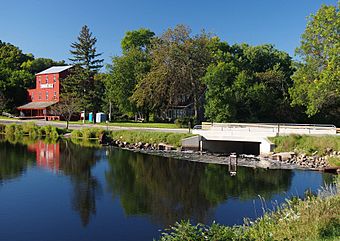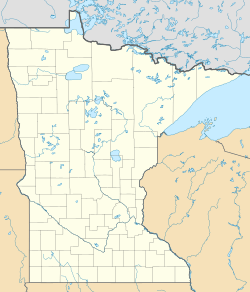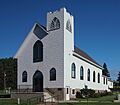Terrace, Minnesota facts for kids
Quick facts for kids |
|
|
Terrace Historic District
|
|

Terrace's historic Terrace Mill and millpond
|
|
| Location | Off State Highway 104, Chippewa Falls Township, Minnesota |
|---|---|
| Nearest city | Sedan, Minnesota |
| Area | 42 acres (17 ha) |
| Built | 1870s–1930 |
| NRHP reference No. | 82002999 |
| Added to NRHP | April 1, 1982 |
Terrace is a small, unincorporated community in Pope County, Minnesota, United States. It was settled in the 1870s around the Terrace Mill. In 1982, a special area called the Terrace Historic District was added to the National Register of Historic Places. This means it's a very important place because it shows what small towns built around mills looked like in the late 1800s. It's a great example of how these communities grew and developed.
History of Terrace
Terrace was started by George Wheeler, John Wheeler, and William Moses. These settlers moved from eastern Canada to Minnesota to build a mill. The town was built on the East Branch of the Chippewa River.
At first, the town was called Chippewa Falls. But people often confused it with Chippewa Falls, Wisconsin. So, the name was changed to Terrace. The first mill moved away around 1895. However, in 1903, a new miller built the Terrace Mill that you can see today. This brought the town's main industry back to life.
What is a Historic District?
A historic district is an area with a group of buildings, structures, or sites that are important to history. The Terrace Historic District includes 13 important properties. These properties are called "contributing properties" because they help tell the story of the district.
Five of these properties, closely linked to the mill, were first listed as the Terrace Mill Historic District in 1979. But in 1982, the larger Terrace Historic District was recognized. This was because the whole community was so well-preserved.
Many small towns that grew around mills were later abandoned. This happened when the mills stopped working or when bigger towns with railroad lines became more popular. It's especially rare to find such well-preserved mill towns in western Minnesota. This area didn't have many settlements until railroads were built.
The buildings in the Terrace Historic District show all parts of a small community. They include places for industry, businesses, schools, social gatherings, churches, and homes.
Images for kids










